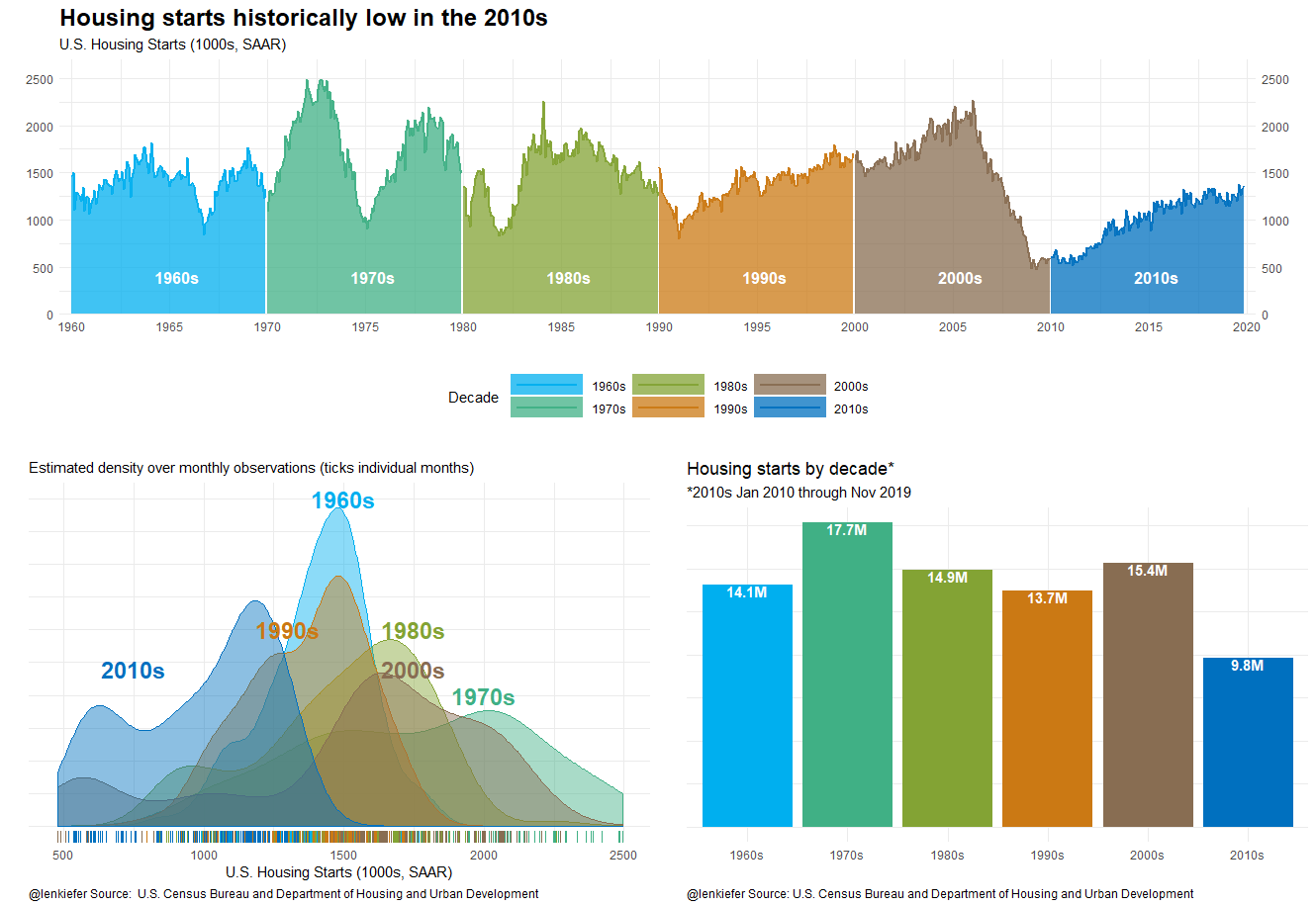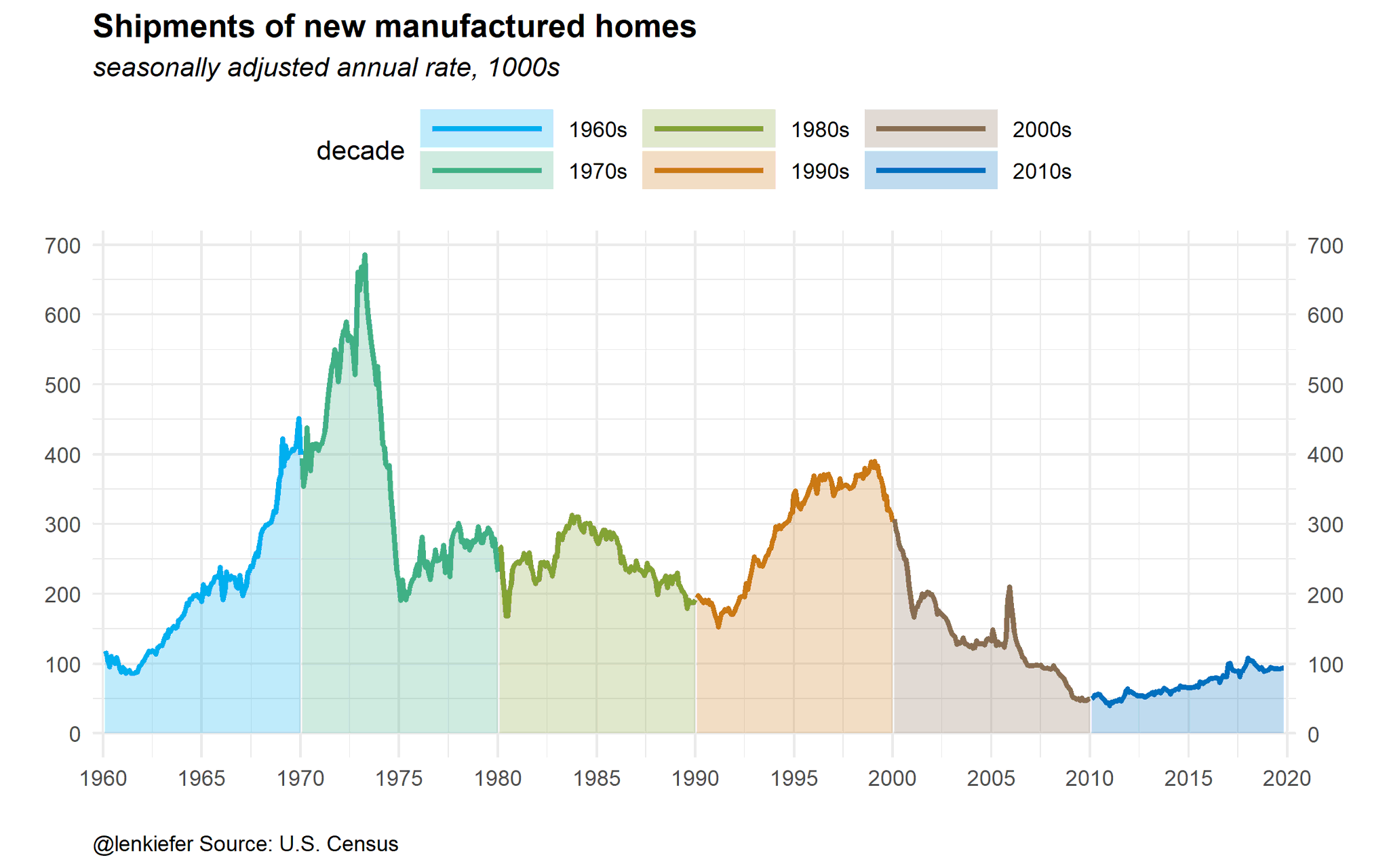
Posted on 01/01/2020 5:50:15 PM PST by grundle
NIMBYism has dominated housing policy for the last ten years. Will the 2020s be any better?
A lot of things happened in the past 10 years. A boom in housing construction was not one of them. The 2010s will go down as a decade of historically low housing starts, resulting in higher home prices and rents for some and longer commutes for others.
Last week, Freddie Mae Deputy Chief Economist Len Keifer tweeted out a graph comparing new housing starts over the past six decades. The results are startling.

In the past 10 years, construction started for 9.8 million new housing units in the U.S. That compares to 15.4 million units in the last decade and 13.7 million in the decade before that. (Keifer notes that those numbers don't include manufactured housing, a traditional source of low-income housing. It increased a little, but not enough to change the pattern.)

The national numbers match what we've seen in some of the highest-cost housing markets in the country.
New York City added 509,000 housing units, or about 2.2 units per new job, from 2001 to 2008, according to a recent report from the city's Department of Planning. It added only 457,000 units, or .5 new units per new job, from 2009 to 2018.
In 2018, the Californian authorities permitted 117,892 new units of housing for the state's nearly 40 million residents, according to California's Department of Finance. By comparison, the Golden State issued 131,732 housing permits in 1975 (the earliest year data is available), despite having only 21.5 million residents.
The question isn't whether government regulation has constrained supply. Rather its which government regulations have restricted supply the most.
Some scholars like to point to zoning restrictions that prevent developers from constructing taller, denser apartment buildings in high-demand urban areas. Others stress urban growth boundaries that block new suburban housing.
On top of this are historical preservation laws, environmental regulations, and prevailing wage requirements for construction workers. Whatever their other policy merits may be these all increase the costs of building new homes.
"The bigger background narrative is NIMBYism generally," says Salim Furth, an urban policy expert at the Mercatus Center. "It's not that localities have planned for housing and have just done it in a way that doesn't produce quite enough. There's a visceral 'just don't build anything here' attitude that is prevailing in most American suburbs today."
A 2016 National Association of Home Builders (NAHB) study estimates that regulatory costs have increased the price of a new single-family home by 30 percent in the first half of the decade. Another NAHB study found that regulations account for a third of new multifamily regulatory costs.
The people who bear the burden of these regulations are renters and new home purchasers who find themselves shelling out more money for the same amount of housing.
An October report from Apartment List put the percentage of cost-burdened renters (those paying more than 30 percent of their income in rent) at just under 50 percent. In 1960 only 24 percent of renters were cost-burdened. Some have chosen to save on housing by spending more time behind the wheel: The Washington Post reports that Americans commuting longer than ever before.
Policy makers are starting to wake up to the problem of a government-induced housing affordability crisis. Occasionally they are even passing good policies.
California has significantly deregulated the construction of granny flats, resulting in a massive spike in the construction of those units in places like Los Angeles. Seattle has done the same, while also upzoning some city neighborhoods to allow for denser residential and commercial development. Oregon and Minneapolis both abolished single-family-only zoning laws.
Alas, these reforms have often been coupled with counterproductive price controls. Both California and Oregon passed caps on rental price increases this year. New York similarly strengthened pre-existing limits on rent increases in New York City. It has also given local governments the authority to pass their own rent control laws.
On balance, Furth believes housing policy is moving in the right direction at the federal and state level. But he thinks that is counteracted at the local level, where the trend is toward giving planners more power to micromanage what new housing will look like.
"That allows local elected officials to have a seat at the table designing and planning everything. They have certain priorities that never include affordability," Furth tells Reason. Local governments have an incentive, he says, to boost tax revenue above all else. That leads them to zone for higher-quality housing that will attract wealthy residents who pay a lot in taxes but consume few services.
In California, the high levels of discretion built into the permitting process allows activists and other self-interested parties to slow down new development. But other cities, such as Des Moines, are moving in the direction of zoning for higher-quality, higher-priced homes.
Some cities, such as Houston, have managed to stay affordable despite tremendous growth precisely because local officials have decided not to micromanage what new housing will look like or where it can be built.
Getting other cities to embrace a lighter-touch regulatory approach requires policy changes. It also requires people to accept having less control over what other people do with their property.
"We need to change the way that we think about property and neighbors," says Furth. "We have a pattern of thinking that is just going to lead to worse and worse outcomes."
>>Some cities, such as Houston, have managed to stay affordable despite tremendous growth precisely because local officials have decided not to micromanage what new housing will look like or where it can be built.
Houston doesn’t have zoning but it’s been run by real estate connected Democrats for over 30 years.
Mayor Lee P. Brown wanted houses that were valued under $200k to disappear. He felt that they cost the city more in services than they were worth to the tax rolls.
Given the shrinking US population, this is no surprise - and if they just traffick foreigners here to prevent ghost towns, who wants to live with/near an imported underclass?
btt
I bought 4 fixer-uppers in Calif. 2 condos and two 3br houses. Did quite well for someone who can only do grunt work and hire out the skilled stuff to dirt bag contractors. Why build new? You gotta get really legal.
Most homes in my area (northeastern NJ) are older; the Dutch started building here in the 1600s, and there isn’t much buildable land available. Also, we’re losing population; no reason to build housing then complain it is empty.
They can’t build houses fast enough in the donut counties around Indy.
10’s of thousands in the area I work occasionally.
Lowest price I’ve seen advertised in “Starting from the $230’s”.
One development near a job I’m on is supposed to have a minimum of 800 that start at $1M.
And all of the shopping, nature trails, sports complexes, parks, schools, arts, entertainment etc that goes with it.
Problem being though, they’re turning a very solid red county into a purple one.
Smaller is better and smarter. Unless you have a family, a large house is a waste of money.
My studio apartment has scrapped the kitchen and has only added a spacious private bathroom.
It feels comfortable without appearing claustrophobic because of the open
design.
You don’t need a large place to live well and be happy.
“Given the shrinking US population, this is no surprise - and if they just traffick foreigners here to prevent ghost towns, who want to live with/near an imported underclass?”
While increased crazy regulations certainly had an impact, you nailed the real culprit. The bottom line is our population IS NOT growing. http://bit.ly/2rKyTRq
It doesn’t take a brain surgeon to see this. The Baby Boomers were the largest cohort ever to move through our economy and society. They had a significant impact on our society as they traveled through. They’ve passed their housing phase and those coming behind them are much smaller population groups (Gen-X and Millenials).
Expect this to continue and even get worse!
IC Clearly
I’ve seen it in action for years now; to make matters worse, our standard of living has declined to the point where 1) young people feel they can’t afford families, and 2) they can’t afford to buy homes for the families they don’t have anyway.
The demographic nightmare is visible for all to see, but it is happening so gradually that it has become “normal” to have a Muslim Arab call our president an MFer.
People like catered living but you need to have a trained staff to run these places and that adds to housing costs.
We contacted 6 builders just outside the Columbia, SC area last year via telephone AND their web contact page. Wanted to build on our waterfront lot. Three never called us back. One of the three we talked to didn’t build in our area, the other two acted like we had the plague. Haven’t built yet...not sure we will.
They forgot to mention the Obama depression. Locally a lot of new construction started soon after Trump’s election.

Millennials don’t see the need
of going into debt for 30 yesrs.
Much less maintaining a house
and property. Those that choose
to live in the basement know
that they’re probably going
to inherit mom and dads place,
who paid off the mortgage for
them. They would just as soon
sell to avoid upkeep and taxes,
move to a smaller rental space
and live off the proceeds of
the sale.
When I turned 18, I was chomping
at the bit to start my own life.
Got married, had kids, and a house
payment. Todays’ young adults are
not of the same mindset.
I should have been more clear: Shrinking AMERICAN population.
My apologies.
True; a friend in a gated community described how the maintenance guys, when clearing the snow in the parking lots, would clean off the cars as well.
Imagine that?
If you are a home owner with a home you’ve had since the prior decade or before, the shortages of new housing and the higher housing prices are fine. If you are a recent, working, high school or college graduate looking to move out of mom and dad’s house, the prices are unaffordable.
Our subdivision is booming with nice sized homes. Every where you look new businesses mostly fast food, or small shopping centers with nichee stores like nail salons, pizza shops, high end 20ish clothing.
Disclaimer: Opinions posted on Free Republic are those of the individual posters and do not necessarily represent the opinion of Free Republic or its management. All materials posted herein are protected by copyright law and the exemption for fair use of copyrighted works.